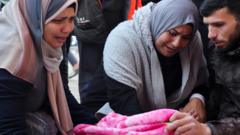The Palestinian death toll from the Gaza war may be drastically underestimated, according to a study led by UK researchers and published in The Lancet medical journal. This investigation was prompted by the conflict that broke out on October 7, 2023, stemming from a Hamas attack on Israel. The study utilized data from the Hamas-run health ministry, alongside online surveys and obituaries, to scrutinize the reported death figures.
As of June 30, 2024, the researchers estimated that approximately 64,260 Palestinians had succumbed to traumatic injuries, suggesting a staggering under-reporting of deaths by around 41%. While the health ministry’s figures are typically regarded as reliable by the United Nations, they do not differentiate between combatants and non-combatants. In stark contrast, a recent UN report indicated that a substantial portion of verified fatalities consists of women and children.
The Israeli government has publicly questioned the validity of Hamas's death toll, with the Israel Defense Forces (IDF) stating in August that over 17,000 militants had been "eliminated." However, the origins of this figure remain uncertain. The IDF asserts that it targets only combatants while striving to limit civilian harm. Compounding the issue, Israel has restricted access to Gaza for international media, complicating efforts to independently verify death counts and the overall situation on the ground.
The research team employed the "capture-recapture" methodology, which has been utilized in previous conflict scenarios for death evaluation. This technique involves cross-referencing different lists of fatalities to identify overlaps, thus providing insights into the potential true extent of the death toll, which researchers believe may be significantly underreported compared to health ministry statistics.
The study suggests a mortality range between 55,298 and 78,525, compared to the health ministry's announced toll of 37,877. Variability in results is inherent to the study's methodology; inaccuracies in identifying deaths from "traumatic injury" could affect the outcome significantly.
Notably, the research indicated that approximately 59% of the deceased, for whom data regarding age and sex was available, consisted of women, children, and the elderly. The ongoing hostilities were induced by a violent Hamas attack resulting in the deaths of roughly 1,200 individuals, along with the abduction of 251 others. In retaliation, Israel initiated extensive military operations in Gaza, which, according to the health ministry, have claimed the lives of 46,006 individuals, predominantly civilians.
As international and local communities continue to grapple with this humanitarian crisis, rigorous and transparent data collection is more important than ever to fully understand the war's devastating effects on the civilian population.
As of June 30, 2024, the researchers estimated that approximately 64,260 Palestinians had succumbed to traumatic injuries, suggesting a staggering under-reporting of deaths by around 41%. While the health ministry’s figures are typically regarded as reliable by the United Nations, they do not differentiate between combatants and non-combatants. In stark contrast, a recent UN report indicated that a substantial portion of verified fatalities consists of women and children.
The Israeli government has publicly questioned the validity of Hamas's death toll, with the Israel Defense Forces (IDF) stating in August that over 17,000 militants had been "eliminated." However, the origins of this figure remain uncertain. The IDF asserts that it targets only combatants while striving to limit civilian harm. Compounding the issue, Israel has restricted access to Gaza for international media, complicating efforts to independently verify death counts and the overall situation on the ground.
The research team employed the "capture-recapture" methodology, which has been utilized in previous conflict scenarios for death evaluation. This technique involves cross-referencing different lists of fatalities to identify overlaps, thus providing insights into the potential true extent of the death toll, which researchers believe may be significantly underreported compared to health ministry statistics.
The study suggests a mortality range between 55,298 and 78,525, compared to the health ministry's announced toll of 37,877. Variability in results is inherent to the study's methodology; inaccuracies in identifying deaths from "traumatic injury" could affect the outcome significantly.
Notably, the research indicated that approximately 59% of the deceased, for whom data regarding age and sex was available, consisted of women, children, and the elderly. The ongoing hostilities were induced by a violent Hamas attack resulting in the deaths of roughly 1,200 individuals, along with the abduction of 251 others. In retaliation, Israel initiated extensive military operations in Gaza, which, according to the health ministry, have claimed the lives of 46,006 individuals, predominantly civilians.
As international and local communities continue to grapple with this humanitarian crisis, rigorous and transparent data collection is more important than ever to fully understand the war's devastating effects on the civilian population.











